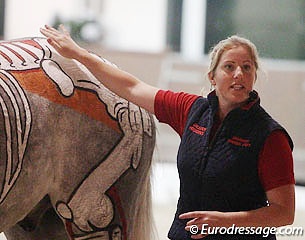
The bubbly British sports and remedial therapist Gillian Higgins explained at very high speed and with much a dense specialised vocabulary equine bio-mechanics relating to dressage movements.
She brought in two beautifully and anatomically correctly body-painted horses as demonstration models for her session.
Sam (by Mermus R) was handled in hand and represented the skeleton and muscles while Lisanne der Nederlanden rode a painted Zigeuner to demonstrate the movement of the bones in action.
Higgins started out by describing the structure and function of the horse’s spine. “There is very little movement in a horse’s back. It’s evolved to carry the heavy weight of the horse’s abdominal contents,” she said.
Bones provide an area for muscle attachment and the lumbar vertebrae is important to help engage and protract the hind limbs. The most movement in the back can be found in the lumbar sacral junction as it is a hinge joint which, through flexion and extension, allows the horse to bring the hindlegs underneath the body.
 By asking Der Nederlanden to ride traversal movements, Higgins wanted to point at the movement of the horse’s ribs. “There is an illusion of uniform bend through the body,” she said. The most bend actually takes place in the horse's neck and less in its body.
By asking Der Nederlanden to ride traversal movements, Higgins wanted to point at the movement of the horse’s ribs. “There is an illusion of uniform bend through the body,” she said. The most bend actually takes place in the horse's neck and less in its body.
While the hip is the pivotal point in the horse’s hindleg in trot, in canter it all changes. “Canter is an asymmetrical gaits and the hind legs are coming through more or less together, uni-laterally,” Higgins explained.
By seeing the skeleton and muscles work on the painted horse, it raised awareness of how equine bio-mechanics work.
The flood of information was much to process and Higgins’ session appeared to be more a physiotherapy course for hard-core professionals. It would have been nice if there was more practical advice on how, for instance, the musculature of dressage horses should be properly managed and how strain on the skeleton and muscles can be prevented.
Next Page of the report: Keeping Up with Nathalie zu Sayn-Wittgenstein
Text & Photos © Astrid Appels/Eurodressage.com - No Reproduction Allowed without permission
Eurodressage Coverage of the 2011 Global Dressage Forum